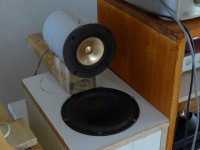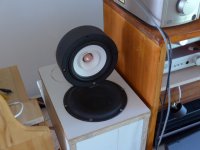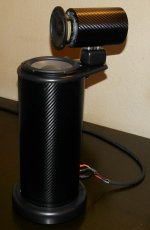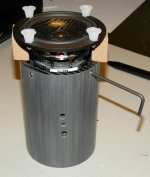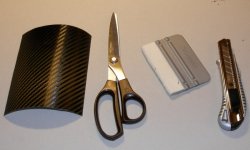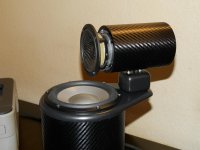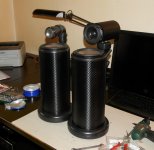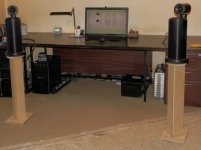Juhazi Here is a Edge sim of it open and closed back. We can see what round "baffle does to treble response. For comparison the datasheet response in large flat and angular baffle sort of LX521 style[/QUOTE said:My curves above were for those who asked me about the freq. response of my mock-up set-up. I understand you simulate them.
Now I am putting the 2-way together just to listen to them working together. See image, the woofer is sealed,.This project is still a work in progress, very promising, enjoy listening to the combo.
BTW I have built many speakers based on many designs including those excellent designs by JK, J. Clayton(Eminence Physics), 2-way cabinet, etc., the speakers from SL's LXMini, this speakers configuration design sounds quite good.. a worthwhile exercise to proceed to completion.
Attachments
Yep, I am not sure at all that a small baffle would sound much different. But isn't it a common procedure around here to pick nits?😎
ttan98: what are you crossing them at? would crossing them lower than SL (at 700Hz?) with a bigger bass driver, change the sound significantly for better or for worse? in other words: does playing 300-700Hz range omnidirectionally do something special for the sound? just asking since you have a chance to experiment. THanks.
ttan98: what are you crossing them at? would crossing them lower than SL (at 700Hz?) with a bigger bass driver, change the sound significantly for better or for worse? in other words: does playing 300-700Hz range omnidirectionally do something special for the sound? just asking since you have a chance to experiment. THanks.
I cannot answer all your questions because I don't own the original LXMini,
1. I cross my LXMini Clone around 700Hz, it depends on your full ranger, even then
you have to raise the lower shelf, lift it about 5-7dB, see SL's curves.
2. This is the first time I design an Omnidirectional speakers, it surely sounds
different the sound is more diffuse rather than directional, if you don't own one try
it, it is cheap to build provided you already own measuring equipment, speakers xover
system with equalizer e.g. Minidsp($85), etc.
A worthwhile exercise. Initial testing and hearing the sound, I believe he overall sound quality is determined primarily by the quality of the full ranger and secondary factors are the quality of the rest of your equipment, eg. amplifier, DAC, etc.
The CHR-70III is by no means the best FR you can get now, an alternative better driver is new model from Mark's Alpair range CHP-7, made from paper, with 87dB spl, easier to drive.
Using a 5in Full Range(FR)
Hi,
I thought you guys maybe interested in my experiment, I switch to a different FR which is a 5in Chinese FR made from paper. I replace the Mark audio 4in CHR-70, the cone is metal coated.
The system sounds totally differently even though the system is equalised for "fairly" flat response. The rest of the system remains unchanged the only change is the full ranger.
The system sound is determined by the type of FR you use. The sound quality of the system is determined by the type,size, etc of the Full Ranger used.
Hi,
I thought you guys maybe interested in my experiment, I switch to a different FR which is a 5in Chinese FR made from paper. I replace the Mark audio 4in CHR-70, the cone is metal coated.
The system sounds totally differently even though the system is equalised for "fairly" flat response. The rest of the system remains unchanged the only change is the full ranger.
The system sound is determined by the type of FR you use. The sound quality of the system is determined by the type,size, etc of the Full Ranger used.
Attachments
Hi TTan, what brand is the 5in Chinese FR made from paper? - looks nice, are they available in Aus?
Hi TTan, what brand is the 5in Chinese FR made from paper? - looks nice, are they available in Aus?
I bought them from Aliexpress.com from China, one pair costs me about US $105. They are a well made drivers, the construction wise and finish. I am very happy with them. They come from the same factory that manufacture the Aucharm 4in which I also own.
Ttan, since you're testing different drivers, why didn't get the SEAS Prestige 4" that SL specifies? They are only $58 each from Madisound.
Graham.
Graham.
Ttan, since you're testing different drivers, why didn't get the SEAS Prestige 4" that SL specifies? They are only $58 each from Madisound.
Graham.
I have 2 FR drivers in hand so I test them first, besides I prefer FR with higher sensitivity than those used by SL(Seas' sensitivity is a 85dB).
Hi,
i bought the plans and built a pair of LXmini like speakers. They sound amazing - much better than pluto.
Michael
Fantastic execution, skilful use of woven textures! Like it a lot, congratulations.
What is the pipes material?
Hi,
the pipes are made of pvc. The carbon design is simple car wrapping foil.
I will have to build new stands, because they are ugly and to tall, if i'm sitting in my armchair. 😀
Michael
the pipes are made of pvc. The carbon design is simple car wrapping foil.
I will have to build new stands, because they are ugly and to tall, if i'm sitting in my armchair. 😀
Michael
Attachments
I'm curious ... anyone that has built the minis tried them lying horizontal?
For what purpose?
On the floor?
Orientated how?
Dave.
Hi, Thanks for your testimonial !
Do you feel a lack of details because the curve deep after 10 K hz ?
At the opposite: how is the low bass ? Has the sound some flesh ?
Do you feel a lack of details because the curve deep after 10 K hz ?
At the opposite: how is the low bass ? Has the sound some flesh ?
Hi Eldam,
the system is capable of very deep frequencies. I use a Linkwitz Transform down to 35 Hz @ qtc=0.71 and the deep bass output is very impressive. This reduces the maximal level - nothing is for free! 🙂
See how Linkwitz-Transform is made with minidsp.
Siegfried equalizes the bass a little bit "softer" and therefore more maximum level is possible but its your choice.
Michael
the system is capable of very deep frequencies. I use a Linkwitz Transform down to 35 Hz @ qtc=0.71 and the deep bass output is very impressive. This reduces the maximal level - nothing is for free! 🙂
See how Linkwitz-Transform is made with minidsp.
Siegfried equalizes the bass a little bit "softer" and therefore more maximum level is possible but its your choice.
Michael
and distortion probably goes off the charts.
10% thd at 40hz, 4-5% 50hz from Pluto, according to the audio critic.
"When I raised the level further, the distortion rose to unacceptable levels at the lower frequencies and the speaker started to buzz."
10% thd at 40hz, 4-5% 50hz from Pluto, according to the audio critic.
An externally hosted image should be here but it was not working when we last tested it.
"When I raised the level further, the distortion rose to unacceptable levels at the lower frequencies and the speaker started to buzz."
Last edited:
I have a couple of questions for the forum:
1) Has anyone listened to the speakers, and if you haven't posted your impressions, could you please?
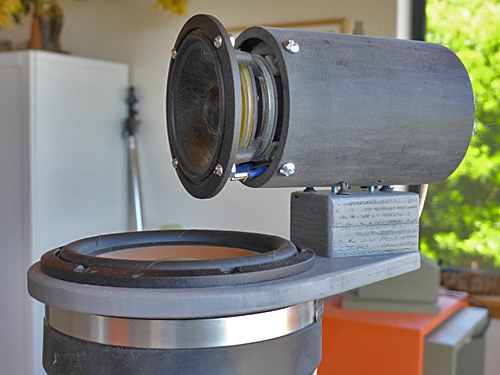
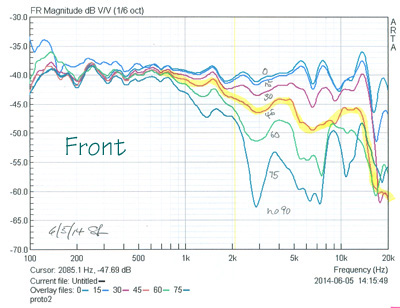
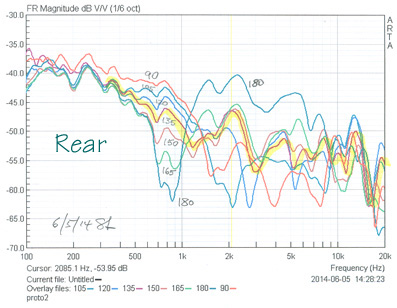
The reason that I ask is that I can't figure out what this speaker offers. I love the sound of cardioids, and fell in love with it when I heard the gradients. But this response isn't cardioid; it varies between monopole, cardioid (briefly) and dipole.
I guess I'm stumped as to why this performance couldn't be easily bested by a waveguide with open back midranges, like the one I built a few months back, or by a cardioid like the Gradient Helsinki.
My hypothesis is that the strange polars are due to the following:
1) The overlap between the midrange and tweeter is not large, and due to this, the dipole radiation is about an octave
2) The strange shape of the enclosure means that the polars will vary dramatically off-axis. (IE, a waveguide would help here. The soft edges of the Helsinki and the B&O speakers is not accidental, it reduces diffraction and smooths the response curves. The LX Mini is full of sharp edges.)
1) Has anyone listened to the speakers, and if you haven't posted your impressions, could you please?



The reason that I ask is that I can't figure out what this speaker offers. I love the sound of cardioids, and fell in love with it when I heard the gradients. But this response isn't cardioid; it varies between monopole, cardioid (briefly) and dipole.
An externally hosted image should be here but it was not working when we last tested it.
I guess I'm stumped as to why this performance couldn't be easily bested by a waveguide with open back midranges, like the one I built a few months back, or by a cardioid like the Gradient Helsinki.
My hypothesis is that the strange polars are due to the following:
1) The overlap between the midrange and tweeter is not large, and due to this, the dipole radiation is about an octave
2) The strange shape of the enclosure means that the polars will vary dramatically off-axis. (IE, a waveguide would help here. The soft edges of the Helsinki and the B&O speakers is not accidental, it reduces diffraction and smooths the response curves. The LX Mini is full of sharp edges.)
Last edited:
- Status
- Not open for further replies.
- Home
- Loudspeakers
- Multi-Way
- New Linkwitz "LXmini" speakers
